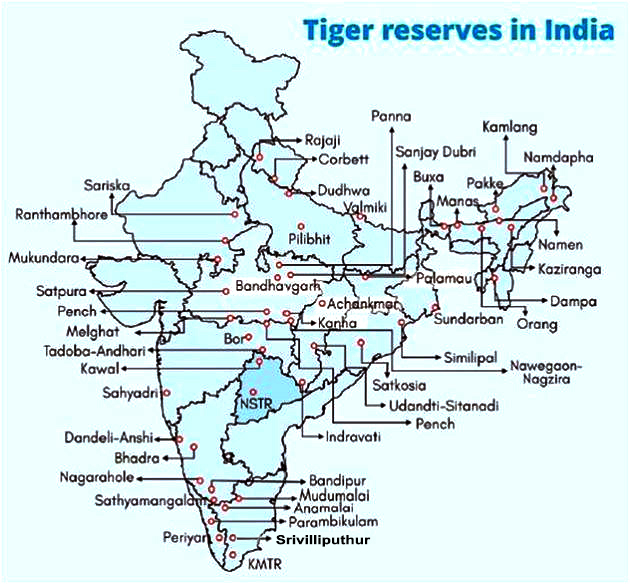International Tiger Day | 30 Jul 2021
Why in News
Recently, at the virtual meeting celebrating International Tiger Day (29th July), Prime Minister of India reiterated India’s commitment to ensuring safe habitats for its tigers and nurturing tiger-friendly eco systems.
- Also, at this meeting, 14 Tiger Reserves in India received the accreditation of the Global Conservation Assured|Tiger Standards (CAITS).
Key Points
- Conservation Status of Tiger:
- Indian Wildlife (Protection) Act, 1972: Schedule I
- International Union for Conservation of Nature (IUCN) Red List: Endangered.
- Convention on International Trade in Endangered Species of Wild Fauna and Flora (CITES): Appendix I.
- Significance of Tiger Conservation:
- Tiger conservation is a symbol of conservation of forests.
- The tiger is a unique animal which plays a pivotal role in the health and diversity of an ecosystem.
- It is a top predator which is at the apex of the food chain and keeps the population of wild ungulates (primarily large mammals) in check.
- Thus, Tiger helps in maintaining the balance between prey herbivores and the vegetation upon which they feed.
- Therefore, Tiger Conservation is not just about saving a beautiful animal.
- It is about making sure that we live a little longer as the forests are known to provide ecological services like clean air, water, pollination, temperature regulation etc.
- Further, the significance of Tiger conservation can be reflected by the Status of Leopards, Co-predators and Megaherbivores-2018’ report.
- According to the report, the overall leopard population in the tiger range landscape of India in 2018 was estimated at 12,852.
- This is a significant increase from the 2014 figure that was 7,910 in forested habitats of 18 tiger bearing states of the country.
- The report is a testimony to the fact that conservation of tigers leads to the conservation of the entire ecosystem.
- Tiger Conservation Projects in India:
- Project Tiger 1973: Project Tiger is a Centrally Sponsored Scheme of the Ministry of Environment, Forests and Climate Change (MoEFCC) launched in 1973. It provides havens for tigers in the country’s national parks.
- National Tiger Conservation Authority (NTCA): It is a statutory body under the MoEFCC and was established in 2005 following the recommendations of the Tiger Task Force.
- India’s Tiger Conservation Status:
- India is home to over 70% of the tiger population globally.
- India is home to 51 tiger reserves spread across 18 states and the last tiger census of 2018 showed a rise in the tiger population.
- India achieved the target of doubling the tiger population four years ahead of schedule (2022) of the St. Petersburg Declaration on tiger conservation.
- India’s strategy of tiger conservation attaches topmost importance to involving local communities.
- Conservation Assured | Tiger Standards (CA|TS):
- CA|TS has been agreed upon as an accreditation tool by the global coalition of Tiger Range Countries (TRCs) and has been developed by tiger and protected area experts.
- There are currently 13 tiger range countries - India, Bangladesh, Bhutan, Cambodia, China, Indonesia, Lao PDR, Malaysia, Myanmar, Nepal, Russia, Thailand and Vietnam.
- CA|TS is a set of criteria which allows tiger sites to check if their management will lead to successful tiger conservation.
- It was officially launched in 2013.
- The Global Tiger Forum (GTF), an international NGO working on tiger conservation, and World Wildlife Fund India are the two implementing partners of the National Tiger Conservation Authority for CATS assessment in India.
- 14 Tiger Reserves which have been accredited are:
- Manas, Kaziranga and Orang Tiger Reserve in Assam,
- Satpura, Kanha and Panna Tiger Reserve in Madhya Pradesh,
- Pench Tiger Reserve in Maharashtra,
- Valmiki Tiger Reserve in Bihar,
- Dudhwa Tiger Reserve in Uttar Pradesh,
- Sunderbans Tiger Reserve in West Bengal,
- Parambikulam Tiger Reserve in Kerala,
- Bandipur Tiger Reserve of Karnataka
- Mudumalai and Anamalai Tiger Reserve in Tamil Nadu.
- CA|TS has been agreed upon as an accreditation tool by the global coalition of Tiger Range Countries (TRCs) and has been developed by tiger and protected area experts.

